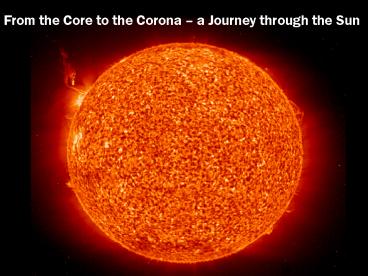Hello Mr. Sun, Sun, Hello Mr. Sun! - PowerPoint PPT Presentation
1 / 22
Title:
Hello Mr. Sun, Sun, Hello Mr. Sun!
Description:
Energy is generated in the core by nuclear fusion ... by using a tool called a coronagraph, which artificially blocks out the disk of the Sun. ... – PowerPoint PPT presentation
Number of Views:387
Avg rating:3.0/5.0
Title: Hello Mr. Sun, Sun, Hello Mr. Sun!
1
From the Core to the Corona a Journey through
the Sun
2
A Model for most stars in the Universe
3
The Suns Core The energy production site
- Temperature about 15 million degrees Kelvin
- Energy is generated in the core by nuclear fusion
- Nuclear fusion is due to great pressures causing
protons from hydrogen to slam into one another
creating helium
The core accounts for 40 of the suns mass,
while only occupying 10 of the total volume. In
other words, the core is really really really
dense
4
The Radiation ZoneUpward and Outward!
- Energy is transported out of the core of the Sun
- Much less dense than core
- Energy has a harder time passing through it.
- Energy is free moving
- It can take hundreds of thousands to millions of
years of years for energy (light) to get out of
the radiation zone
5
The Radiation Zone
- Towards the edge of the radiation zone, the
temperature cools enough that the energy from the
core cannot move freely. - Instead it gets absorbed by the plasma (hot gas
of the Sun) and starts a process known as
convection.
6
Convection Zone
- The outermost layer of the Suns interior layers
- Brings light and energy to the surface of the Sun
through convection currents - Temperature range from 2 million to 6,000 degrees
Kelvin.
7
The Photosphere
- The lower atmosphere of the Sun
- This is where the energy finally is released,
mostly as thermal energy, but also as the visible
light we see. - The coolest region of the Sun (6000 Kelvin)
8
Granulation
- The Suns photosphere looks like rice grains.
- Large convection cells cause this granulation,
since each cell has a column of hot gas rising
and cool gas descending. - Granules the size of Earth and larger constantly
evolve and change in a churning kind of motion.
9
Chromosphere
- The region immediately above the photosphere
- 2000-3000 km thick
- Glows faintly relative to the photosphere
- Can only be seen easily in a total solar eclipse
- Temperature is about 20,000 degrees Kelvin
- Primary source of UV radiation
10
The Solar Corona
- The corona is extended outer atmosphere of the
Sun - 1 million times less bright than the photosphere
- Can only be seen during a total solar eclipse or
by using a tool called a coronagraph, which
artificially blocks out the disk of the Sun.
11
- The Suns surface temperature is about 6,000
degrees K - The temperature in the corona reaches about 1
million degrees K
12
(No Transcript)
13
The Solar Wind
- A constant stream of particles flows from the
Suns corona, with a temperature of about a
million degrees and with a velocity of about 450
kilometers per second. - The solar wind reaches out beyond Pluto's orbit
(about 5900 million kilometers). - This wind helps
- shape the magneto-
- spheres of planets
- and blows off the
- material that forms
- the tails of comets.
14
The Path of Sunspots
- Because of differential rotation, the magnetic
field of the Sun is very much different from that
of the Earth. - Sunspots often occur in pairs along these lines.
15
The Path of Sunspots
- Strong magnetic forces prevent the mixing of
cooler and warmer areas, which creates the
appearance of sunspots. - This is also the path for solar prominences
16
The Path of Sunspots
- Notice how the prominence seems to loop similar
to the magnetic field
17
The Path of Sunspots
- Sunspot Cycle sunspot maximum occurs every 11
years. Last sunspot maximum was in 2001.
18
Solar Prominences
- A fairly common occurrence
- They are eruptions caused by magnetic forces.
Cooler gases above the photosphere can often be
seen flowing along magnetic field lines.
19
(No Transcript)
20
Large Solar Prominences
- This is the largest prominence observed.
- This huge prominence is 100,000 kilometers above
the Sun.
28 Earths high
21
(No Transcript)
22
Some Neat Little Ditties.
- How do we know the temperature of the Sun?
- Wienss Law Hotter bodies radiate more energy
at shorter wavelengths. - Each wavelength has its own color
- So, temperature is related to surface color of
the star and hotter stars are brighter if seen
from the same distance - How do scientists know that the Sun has a core?
- The only thing that provides enough energy to
heat a star for billions of years is nuclear
fusion. - How long until the Sun explodes?
- About 5,000,000,000 years.
- How do we know the composition of the Sun?
- The solar wind and spectra analysis.
- Sunspot Cycle
- sunspot maximum occurs every 11 years. Last
sunspot maximum was in 2001. - One second of its Energy total energy produced
in the US for 90 years































